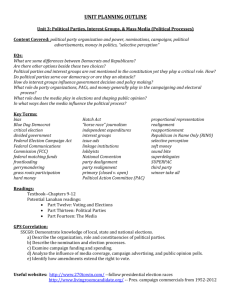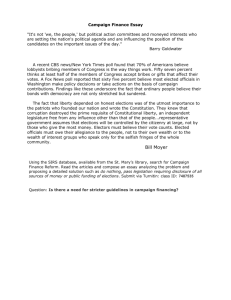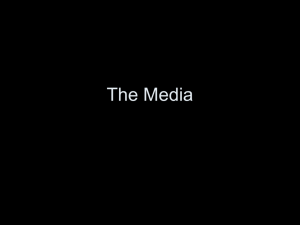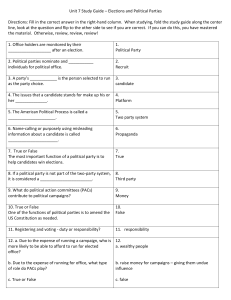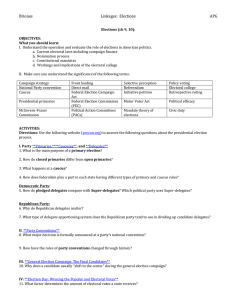Election Campaigns
advertisement
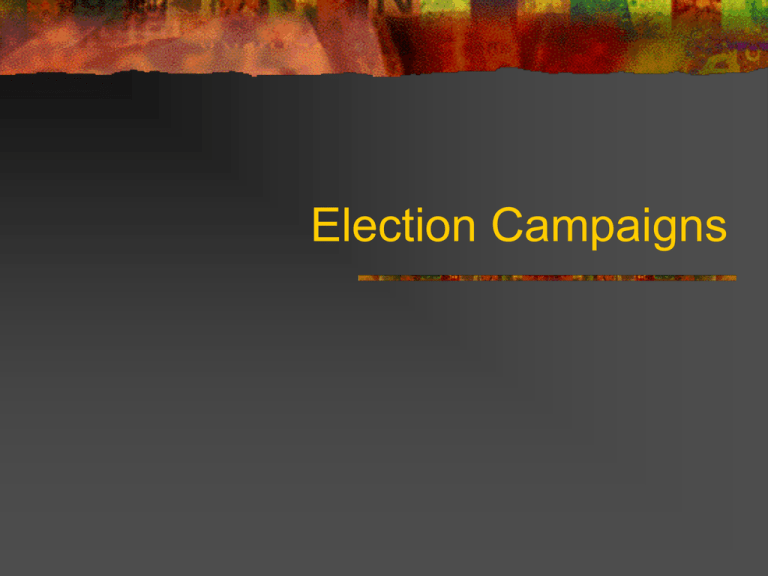
Election Campaigns 1st Period Quiz Name the three types of elections other than the Presidential Election that are mentioned in this section. Name the three major steps in Presidential Elections What is the electoral college? Types of Elections General Primary Special Primary Elections Primary elections are held to narrow the field of candidates in an election. General Elections General elections are held on the first Tuesday in November. This year the date is November 6th. General elections can include Presidential Elections, State Elections, Congressional Elections, and Local Elections. Special Elections Special elections are elections that are held outside of the normal election season. Special Elections can involve the replacement of a candidate or person in office due to their death or resignation. Runoff elections are elections that are held when voting is tied in an election. Recall elections are held to recall an official from office. (California 2000) “We want you to run for president….” Presidential Elections Presidential Elections have three major steps: Nomination Campaigns The Vote The Nomination Generally, party presidential candidates are nominated at their respective National Conventions. National Conventions are held during the summer months of Presidential Election years. They generally kick off the campaign season* Campaigns Presidential Campaigns usually are in full swing by September during election years. However, campaigning does begin years in advance by some candidates.* Political Ads appear in media outlets (Newspapers, TV, Radio) Campaign stops include town hall meetings, debates, parades, news conferences The Vote/Electoral College Remember presidents are not elected by popular votes, rather by the Electoral College. The Electoral College is the group of electors that elects the President. There is a slate or list of electors that are pledged to each candidate. Electoral College The Candidate that wins the popular vote in a state usually receives all of the state’s electoral votes. (winner-take all) There are 538 Electoral Votes up for grabs during Election night. 538 Formula 100 Senators 435 House of Representatives 3 Votes from DC = 538 Votes in the Electoral College *Remember 270 are needed to win the presidency! So here’s the debate: Should we do away with the electoral college? 2 Volunteers from each class will be asked to debate this issue in front of your classmates. Tip O’Neill “There are four parts to any campaign. The candidate, the issues…, the campaign organization and the money. Without money you can forget the other three.” Show me the Money…Campaign Funding Once candidates are nominated they spend weeks and months campaigning for elections. They cost money. The purpose of campaigns is to convince the public to vote for a particular candidate. Finance Controls In 1971, Congress passed the Federal Election Campaign Finance Act of 1971 and it’s amendments in 1974 ad 1979. This act establishes the rule of campaign finance today. Campaign Funds: Just where does the money come from? Campaign Money comes from both public and private funds. Campaign Workers-The Heart and Soul of Campaigns Campaign workers work hard on campaigns to make their candidate’s name be heard. They must acquaint voters with the issues, the name of the candidate and to trust their candidate. They use several techniques in order to accomplish this. The Methods Canvassing Endorsements Advertising and Image Molding Canvassing • • When candidates or campaign workers travel through neighborhoods asking for votes, or taking public opinion polls. City Candidates or local candidates often go door to door. Endorsements When a famous and popular person supports or campaigns for a president. Endorsements are a type of propaganda technique used frequently on the campaign trail Propaganda Techniques There are several types of propaganda techniques used on campaign trails. They include Endorsements Stacked Cards Name Calling Glittering Generality Propaganda Symbols Just Plain Folk The Bandwagon Endorsements The idea behind endorsements is that if people admire the person endorsing a campaign or produced they will support them. Stacked-Cards Also known as Card stacking Is used to present one side of an issue and it often distorts the facts. Name-Calling An attempt to turn people against an opponent or an idea. They label the person in a negative and often demeaning way. Glittering Generality A statement that sounds good but is meaningless. In simple terms it is a “lie” Symbols Political candidates and interest groups use and misuse symbols when appealing to the public. Just Plain Folks The idea behind the plain-folks appeal is to make people think that the candidate is just like them. The Bandwagon This technique appeals to the desire to be on the winning team, to be number one. 3rd Period for Friday • For Friday, • • After lunch we will have a debate over current issues that will be on the forefront of the 2008 Election. The issues that we will debate in class are Energy, Welfare, Health Care, Social Security, Homeland Security, Jobs and Job Security, and Education


